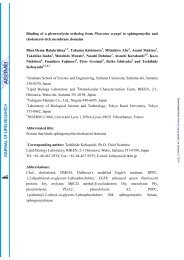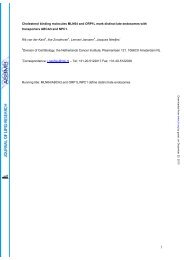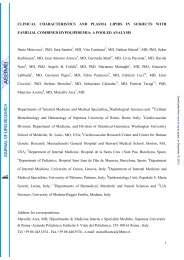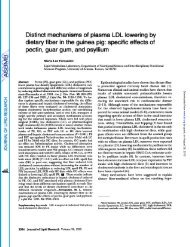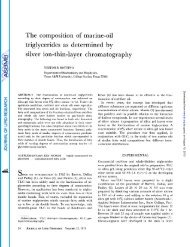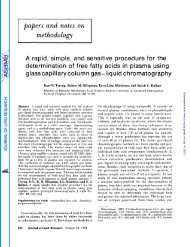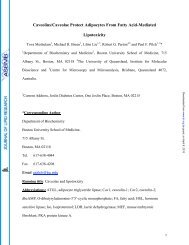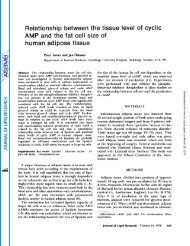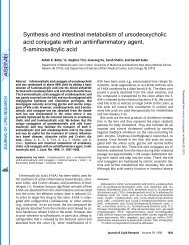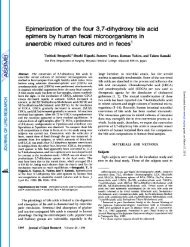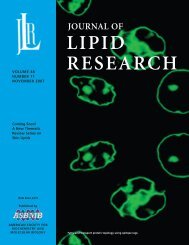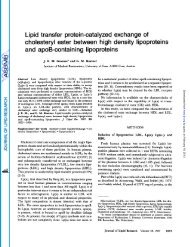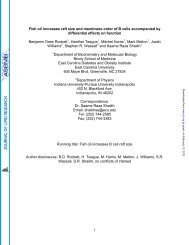Cholesterol gallstone dissolution in bile - The Journal of Lipid ...
Cholesterol gallstone dissolution in bile - The Journal of Lipid ...
Cholesterol gallstone dissolution in bile - The Journal of Lipid ...
You also want an ePaper? Increase the reach of your titles
YUMPU automatically turns print PDFs into web optimized ePapers that Google loves.
ploy<strong>in</strong>g the rotat<strong>in</strong>g disk and static disk methods.<br />
As predicted by Levich's equation (Eq. 2), the rotat<strong>in</strong>g<br />
disk data is l<strong>in</strong>ear and passes through the orig<strong>in</strong>. As<br />
<strong>in</strong>dicated <strong>in</strong> footnote 4, these results are valid only<br />
for the rotat<strong>in</strong>g disk experiments. Even though the<br />
static disk data also <strong>in</strong>tersects the orig<strong>in</strong>, the k values<br />
at any value <strong>of</strong> 6.P are significantly less than the rotat<strong>in</strong>g<br />
disk results. Thus at zero stirr<strong>in</strong>g rates, if the<br />
conditions were truly stagnant, no <strong>dissolution</strong> <strong>of</strong> benzoic<br />
acid should be possib1e.j<br />
Influence <strong>of</strong> stirr<strong>in</strong>g speed on <strong>dissolution</strong> rates <strong>of</strong><br />
ChM <strong>in</strong> CDC solutions-static disk method<br />
In order to determ<strong>in</strong>e a suitable stirr<strong>in</strong>g speed for<br />
subsequent experiments, the <strong>dissolution</strong> rates <strong>of</strong><br />
ChM were determ<strong>in</strong>ed <strong>in</strong> 100 mM CDC (37"C, pH<br />
10.0) for stirr<strong>in</strong>g rates which varied between 40-<br />
500 r.p.m. (Fig. 4). <strong>The</strong> <strong>dissolution</strong> rates <strong>in</strong>crease<br />
progressively with <strong>in</strong>creas<strong>in</strong>g stirr<strong>in</strong>g rates to 300<br />
r.p.m. and then fall slightly at 500 r.p.m. <strong>The</strong> <strong>in</strong>set<br />
shows the <strong>in</strong>crease <strong>in</strong> <strong>dissolution</strong> rate constant (k)<br />
as a function <strong>of</strong> <strong>in</strong>creases <strong>in</strong> stirr<strong>in</strong>g speed (wl'*). Even<br />
though the Levich equation cannot be applied to static<br />
disk <strong>dissolution</strong> studies ow<strong>in</strong>g to the complexity <strong>of</strong> the<br />
velocity pr<strong>of</strong>ile at the surface <strong>of</strong> the disk, the data<br />
suggest (as is proven subsequently) that ChM <strong>dissolution</strong><br />
is not diffusion-controlled <strong>in</strong> view <strong>of</strong> the large<br />
positive <strong>in</strong>tercept at zero stirr<strong>in</strong>g rates. A stirr<strong>in</strong>g<br />
rate <strong>of</strong> 300 r.p.m. was used rout<strong>in</strong>ely for most <strong>of</strong> the<br />
subsequent <strong>dissolution</strong> experiments.<br />
Dissolution <strong>of</strong> ChM and ChA <strong>in</strong> solutions <strong>of</strong> CDC<br />
and UDC and their conjugates-static disk method<br />
<strong>The</strong> <strong>dissolution</strong> rates <strong>of</strong> ChM <strong>in</strong> 100-mM solutions<br />
<strong>of</strong> CDC and its conjugates and <strong>in</strong> UDC and its conjugates<br />
are displayed <strong>in</strong> Fig. 5A and the <strong>dissolution</strong><br />
rates <strong>of</strong> ChA <strong>in</strong> 100-mM solutions <strong>of</strong> CDC, GCDC,<br />
TCDC, and UDC are plotted <strong>in</strong> Fig. 5B, respectively.<br />
As the amount <strong>of</strong> cholesterol dissolved <strong>in</strong>creases as a<br />
function <strong>of</strong> time, the <strong>dissolution</strong> rates decrease and<br />
level <strong>of</strong>f as micellar saturation is approached. In each<br />
case <strong>in</strong>itial <strong>dissolution</strong> rates and f<strong>in</strong>al solubilities <strong>of</strong><br />
ChA are appreciably greater than ChM, with the<br />
former display<strong>in</strong>g no evidence <strong>of</strong> nucleation over the<br />
duration <strong>of</strong> the experimental period (20 hr). <strong>The</strong> <strong>dissolution</strong><br />
rates and solubilities <strong>of</strong> both ChM and ChA<br />
are markedly (up to 20-fold) greater <strong>in</strong> CDC solutions<br />
than <strong>in</strong> UDC solutions. <strong>The</strong> equilibrium solubilities,<br />
' In real systems even when there is no stirr<strong>in</strong>g, conditions are<br />
usually not stagnant because <strong>of</strong> natural convection from pressure,<br />
temperature and density fluctuations <strong>in</strong> the solvent. Hence some<br />
<strong>dissolution</strong> <strong>of</strong> diffusion controlled substances always occurs <strong>in</strong> the<br />
absence <strong>of</strong> stirr<strong>in</strong>g.<br />
I<br />
25f<br />
4<br />
HOURS<br />
Fig. 4. Influence <strong>of</strong> stirr<strong>in</strong>g speed (r.p.m.) on the <strong>dissolution</strong><br />
rates <strong>of</strong> static disks <strong>of</strong> cholesterol monohydrate (ChM) (100 mM<br />
CDC, 37"C, pH 10.0, 0.15 M Na+, 25 ml). Inset: <strong>dissolution</strong> rate<br />
constants (k) versus the square root <strong>of</strong> the impeller's angular<br />
velocity ( d 2 ) <strong>in</strong> radians.sec".<br />
saturation ratios, <strong>dissolution</strong> rates, and <strong>dissolution</strong><br />
rate constants calculated from the curves <strong>in</strong> Fig. 5A<br />
and B are listed <strong>in</strong> Table 1. <strong>The</strong>se data show that<br />
the magnitude <strong>of</strong> the <strong>dissolution</strong> rates have the rank<br />
order <strong>of</strong> ChA > ChM, free <strong>bile</strong> salts >conjugates,<br />
and CDC series >> UDC series. Further, the <strong>dissolution</strong><br />
rate constants (k) for the CDC series are about 2 to<br />
%fold larger than the rate constants for the<br />
series.<br />
UDC<br />
Powder <strong>dissolution</strong> studies <strong>of</strong> ChM and ChA <strong>in</strong><br />
solutions <strong>of</strong> CDC, UDC, and their conjugates<br />
S<strong>in</strong>ce the maximum ChA solubility <strong>in</strong> each <strong>bile</strong> salt<br />
solution was higher than that <strong>of</strong> ChM (Table 1, Fig. 5A<br />
and B) and was stable for the duration <strong>of</strong> the static<br />
disk experiments (20 hr), we carried out <strong>dissolution</strong><br />
experiments us<strong>in</strong>g an excess <strong>of</strong> f<strong>in</strong>ely powdered<br />
cholesterol (ChA and ChM) (see Methods) <strong>in</strong> order<br />
to <strong>in</strong>duce nucleation <strong>of</strong> the <strong>bile</strong> salt systems which<br />
had become supersaturated with ChM (Fig. 6A, 6B).<br />
In the case <strong>of</strong>- CDC and its conjugates, an <strong>in</strong>itial peak<br />
<strong>in</strong> cholesterol solubility is reached dur<strong>in</strong>g the first day<br />
<strong>of</strong> <strong>dissolution</strong> and thereafter these higher solubilities<br />
approach the equilibrium ChM values. After 2-4<br />
days, both ChM and 'ChA' solubilities become identical<br />
(Fig. 6A, 6B) and rema<strong>in</strong> so for the duration <strong>of</strong><br />
the experiment. In the case <strong>of</strong> UDC (Fig. 6A and 6B),<br />
the higher solubilities <strong>of</strong> ChA took 3-4 days to atta<strong>in</strong><br />
the lower solubility <strong>of</strong> ChM but <strong>in</strong> the case <strong>of</strong> GUDC<br />
and TUDC, no nucleation <strong>of</strong>- hydrated ChA was evident<br />
over the 21-day experimental period (Fig. GB).<br />
Igimi and Carey K<strong>in</strong>etics <strong>of</strong> cholesterol <strong>gallstone</strong> <strong>dissolution</strong> 259<br />
Downloaded from<br />
www.jlr.org by guest, on June 9, 2013



